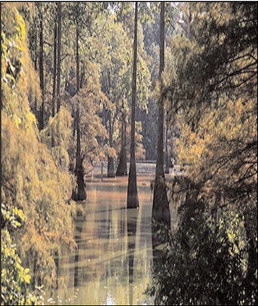Oxbows provide a natural option for anglers

The Natural State a haven for prime fishing spots
AGFC Regional Educator JONESBORO — Arkansas is blessed with a multitude of fishing holes. Manmade reservoirs, and large rivers to upland streams and small ponds, Arkansas has almost anything a fisherman could want.
Oxbow lakes lining many of Arkansas’s lowland rivers offer an experience seldom found in other fishing locations. These oxbows range in size from just a few acres to the largest oxbow lake in North America, Lake Chicot in Southeast Arkansas. Some of these wonderful gems have great public access while many are on private land and landowner permission must be attained to gain access.
An oxbow lake is created when the meandering curves of a river are cut off from the main channel by sediment deposits. Oxbow lakes can sometimes become totally isolated from the river itself, though most retain some connection to the river. This connection allows the lakes to be recharged occasionally by high water levels, thus maintaining the vitality of the fishery.
Oxbow lakes are most often populated with fish that inhabit the lowland rivers of Arkansas. Species most often targeted by anglers include crappie, bream, catfish and largemouth bass. Rough fish such as bowfin (grinnell), various types of gar, buffalo and carp can usually be found as well.
These lakes offer great fishing options throughout the year, but summer is a special time to fish an oxbow. Their “U” or comma shape enables cypress and tupelos along the shoreline to provide shade throughout the day.
Another added bonus to an oxbow trip is the abundance of wildlife often found along the banks.
Birds of many kinds rely on the habitat surrounding oxbows. Anglers often fish while enjoying the serenade of woodpeckers, barred owls, prothonotary warblers, shorebirds and waterfowl. Mammals like squirrels, mink, beaver, deer and even bear often find the banks of an oxbow attractive.
Fishing an oxbow can be a fairly simple venture.
Lakes with boat launches provide opportunities for larger boats while some of the smaller lakes are better suited for jon boats that can be slid in and out of a pickup or kayaks and canoes that can be toted to the water’s edge.
Basic fishing equipment will usually suffice for an outing on an oxbow.
Crappie can be targeted with a simple cane or telescopic pole with a short length of line, but most fishermen opt for a little more advanced setup with a 10- to 12-foot jigging pole with a small spinning reel spooled with 6-pound line. A no.2 light wire hook fished with a minnow 2 to 3 feet deep around the cypress or brush piles will often be effective.
Black/chartreuse or red/chartreuse jigs fished on an 1/2-ounce jighead are a go-to for many seasoned anglers. Another color to consider is clear or pearl with sparkles that mimics a small baitfish or freshwater
Continued on Page 9 OXBOWS (cont.)
shrimp.
A variety of sunfish species can be found, including bluegill, redear, warmouth and longear. They can be caught readily with the same 10- to 12-foot pole used for crappie or by casting with a light spinning rod. A no. 6 light wire hook with a cricket or worm fished about 1 to 2 feet deep around and behind the cypress trees can produce some great action.
Largemouth as well as an occasional spotted bass can also be caught in these fishing holes. White or chartreuse spinnerbaits, crankbaits that resemble a shad or bluegill or soft plastics that mimic crawdads can all be effective.
An exciting option to target the bass is a topwater frog or buzzbait either early or late in the day. Bass tackle might need to be a little on the heavier side since these fish are most often caught around heavy cover.
Though not often targeted in these backwaters, channel catfish can be pursued with stinkbait or worms fished on the bottom of an oxbow. Larger live bait might also produce a flathead if it can beat a gar or grinnel to the bait. If trotlines are used they need to be checked frequently. Hot water with no current can cause fish to die on the line in just a couple of hours.
There are a few anglers out there who like to target rough fish that inhabit the oxbows. Large grinnel can be caught with spinnerbaits while trophy size longnose gar can often be hooked on large live bait. This is a great option for someone just looking for a tug on the line.
Map reading is an essential part of finding these lakes.
While some are wellknown and the routes are marked with signs, others are off the beaten path.
County maps, national refuge maps and wildlife management area maps can be great resources to find a honey hole. Another excellent tool is the AGFC’s Interactive Map at agfc.com. It will show any public accesses on a particular body of water and has a map layer that will highlight ownership of the property to tell you if an oxbow is public or privately owned.
Visit www.agfcnaturecenter. com for more basic fishing information from Chuck Long and other educators at the Arkansas Game and Fish Commission.




Share